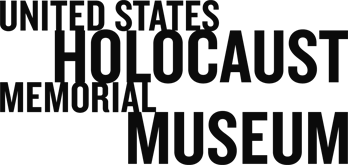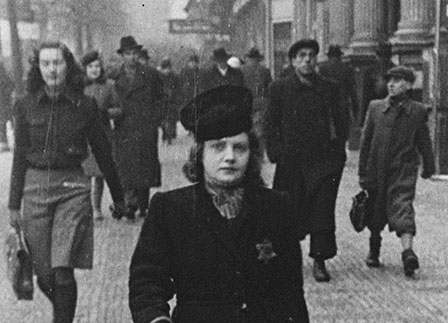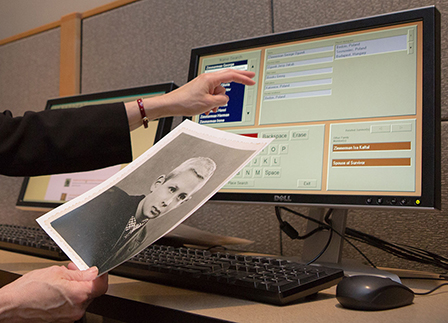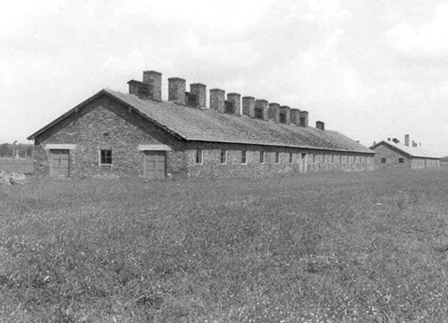Overview
- Brief Narrative
- Boxed Tisch-Tennis (Table Tennis) or ping pong set with net, 2 paddles, 6 balls, and instruction sheet brought with 8 year old Anneliese Centawer when she and her parents James and Recha fled Nazi Germany in July 1938. After Hitler and the Nazi regime's seizure of power in 1933, the Jewish population was subjected to increasingly harsh persecution. In 1936, Anneliese's family was forced to move from their home in Nuremberg when their block was declared Judenfrei (Free of Jews.) Anneliese was beaten up on the street by a Hitler Youth who accused the freckled, red haired girl of trying to pass for German. In July 1938, with sponsorship from Recha's half-siblings in the US, the family arrived in New York.
- Date
-
emigration:
1938 July
- Geography
-
received:
Nuremberg (Germany)
- Credit Line
- United States Holocaust Memorial Museum Collection, Gift of Anneliese C. Marx
- Markings
- a. top, center, pressed, silver colored paint : Tisch-Tennis [Table Tennis]
h. surface, stamped, blue and red ink : WINDSOR / MAJOR / >>>
i. surface, stamped, red ink : Ping Pong / Rekord
j. surface, stamped, blue and black ink : Tatro / MADE IN / ENGLAND - Contributor
-
Subject:
Anneliese C. Marx
- Biography
-
Anneliese Centawer was born on January 10, 1930, to James and Recha Huetzler (Hützler) Centawer in Nuremberg, Germany. Her mother Recha was born on June 23, 1891, in Huettenbach, Germany, to Moritz (1840-1922) and Amalie Selig Huetzler (1857-1918.) Recha had four younger brothers and nine half-siblings from her father’s first marriage to Babette Talman. Recha was part of a very wealthy and large, extended family which owned several department stores and extensive financial holdings. Several family members immigrated to the United States in the 1880s. Recha’s father was a cattle dealer. Anneliese’s father James was born on July 21, 1888, in Nuremburg to Moritz (1830-1920) and Marie Gutmann Centawer (1854-1932.) His father operated a shoestore. James had a sister Henriette. James was a lieutenant in the German Army during World War I (1914-1918.) He then became the European trade representative for an electrical company that manufactured transformers. James and Recha married on August 17, 1924, and settled in Nuremberg. After the January 1933 appointment of Adolf Hitler as Chancellor of Germany, the Nazi dictatorship enacted plans to persecute Jews and exclude them from German society. Anneliese attended the Israelitsche Folkshul and was taught German and Jewish subjects. Antisemitism increased and, on one occasion, Anneliese was beaten by a member of the Hitler Youth who, because of her red hair and freckles, accused Anneliese of trying to pretend to be a German. In 1936, the family had to move because their block was declared Judenfrei [Free of Jews.] In March 1938, with sponsorship by three of Recha's half-siblings in the US, the family received American visas. Anneliese and her parents sailed from Hamburg on the Manhattan and arrived on July 7, 1938, in New York.
The family settled in the Bronx in New York City. During the war, Anneliese’s father James worked for the US Office of War Information in the censorship bureau and then for the US Treasury Department. They learned that three of Recha's half-siblings: Ida, Leopold, and Siegmund Huetzler, perished during the Holocaust. James’s sister Henrietta is believed to have been killed in a concentration camp gas chamber. Anneliese graduated from Hunter College High School and received a cum laude degree from Hunter College in 1951. On August 26 of the same year, she married Gunther Marx. Gunther, born in 1926, in Remscheid, Germany, had fled to England, and then to America with his parents in 1939. He was a sergeant in the US Army during the war, from 1944-1946. The couple had a son. Anneliese pursued a career in public relations and was a corporate management consultant. Her mother Recha, 79, passed away on June 22, 1970. Her father James, 87, died on January 26, 1976.
Physical Details
- Classification
-
Toys
- Category
-
Games
- Object Type
-
Table tennis (lcsh)
- Physical Description
- a. Rectangular, cardboard box lid for base (b.) covered on the exterior with bright red, textured paper with the German game name in impressed, silver painted text. The sides are stapled at the corners. It has loose and detached sections.
b. Rectangular, red cardboard box base for lid (a.) with a light brown interior. The short flaps on the long sides fold in and are stapled.
c. Light brown, wooden table tennis racket with a wide, flat, oval blade and a short neck glued into the slot at the top of a beveled, cylindrical handle. The handle is worn smooth from use.
d. Light brown, wooden table tennis racket with a wide, flat, oval blade and a short neck glued into the slot at the top of a beveled, cylindrical handle. The handle is worn smooth from use.
e. Long, narrow, discolored strip of green net with white cloth binding tape sewn along the top. At each end, the tape is threaded through a small hole in the top of a silver colored metal bar with C-shaped bottom hooks. The hooks attach to table edges to create upright posts to suspend the net. During play, the ball is hit over the net.
f. Small, hollow, discolored white plastic ball with a large and small dent on one side.
g. Small, hollow, discolored white plastic ball with a large and small dent on one side.
h. Small, hollow, discolored yellow plastic ball with a stamped name.
i. Small, hollow, discolored white plastic ball with a stamped name and small cracks.
j. Small, hollow, discolored white plastic ball with a stamped name.
k. Small, hollow, discolored white plastic ball with brown stains.
l. Light brown sheet of paper with game instructions in German text printed in black ink on the front. - Dimensions
- a: Height: 1.500 inches (3.81 cm) | Width: 9.750 inches (24.765 cm) | Depth: 6.125 inches (15.558 cm)
b: Height: 1.500 inches (3.81 cm) | Width: 9.750 inches (24.765 cm) | Depth: 5.875 inches (14.923 cm)
c: Height: 10.000 inches (25.4 cm) | Width: 5.000 inches (12.7 cm) | Depth: 0.625 inches (1.588 cm)
d: Height: 10.000 inches (25.4 cm) | Width: 5.000 inches (12.7 cm) | Depth: 0.750 inches (1.905 cm)
e: Height: 5.875 inches (14.923 cm) | Width: 38.000 inches (96.52 cm) | Depth: 0.375 inches (0.953 cm)
f-k: | Diameter: 1.375 inches (3.493 cm)
l: Height: 6.250 inches (15.875 cm) | Width: 4.500 inches (11.43 cm) - Materials
- a : cardboard, paper, paint, metal, adhesive
b : cardboard, metal, paint
c : wood, adhesive
d : wood, adhesive
e : net, metal, cloth
f-k : plastic
l : paper, ink
Rights & Restrictions
- Conditions on Access
- No restrictions on access
- Conditions on Use
- No restrictions on use
Keywords & Subjects
Administrative Notes
- Legal Status
- Permanent Collection
- Provenance
- The game was donated to the United States Holocaust Memorial Museum in 2013 by Anneliese Marx.
- Funding Note
- The cataloging of this artifact has been supported by a grant from the Conference on Jewish Material Claims Against Germany.
- Record last modified:
- 2022-09-12 12:41:28
- This page:
- https://collections.ushmm.org/search/catalog/irn90823
Download & Licensing
In-Person Research
- By Appointment
- Request 21 Days in Advance of Visit
- Plan a Research Visit
- Request to See This Object
Contact Us
Also in Anneliese Centawer Marx family collection
The collection consists of six games, two composition books, documents, and photographs relating to the experiences of Anneliese Centawer and her family before the Holocaust in Nuremberg, Germany, and during and after the Holocaust in the United States, after leaving Germany in July 1938.
Date: 1903-1938
![Denk fix! [Think Quick] game turntable spinner, cards, and box brought with a young German Jewish refugee Denk fix! [Think Quick] game turntable spinner, cards, and box brought with a young German Jewish refugee](https://www.ushmm.org/media/emu/get?irn=90817&mm_irn=26213&file=secondary)
Denk fix! [Think Quick] game turntable spinner, cards, and box brought with a young German Jewish refugee
Object
Denk Fix! [Think Quick!] card and question/answer game with spinner brought with 8 year old Anneliese Centawer when she and her parents James and Recha fled Nazi Germany in July 1938. After Hitler and the Nazi regime's seizure of power in 1933, the Jewish population was subjected to increasingly harsh persecution. In 1936, Anneliese's family was forced to move from their home in Nuremberg when their block was declared Judenfrei (Free of Jews.) Anneliese was beaten up on the street by a Hitler Youth who accused the freckled, red haired girl of trying to pass for German. In July 1938, with sponsorship from Recha's half-siblings in the US, the family arrived in New York.
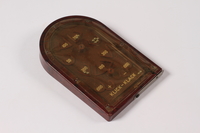
Klick-Klack handheld pinball game with box brought with a young German Jewish refugee
Object
Klick Klack, a handheld pinball game brought with 8 year old Anneliese Centawer when she and her parents James and Recha fled Nazi Germany in July 1938. After Hitler and the Nazi regime's seizure of power in 1933, the Jewish population was subjected to increasingly harsh persecution. In 1936, Anneliese's family was forced to move from their home in Nuremberg when their block was declared Judenfrei (Free of Jews.) Anneliese was beaten up on the street by a Hitler Youth who accused the freckled, red haired girl of trying to pass for German. In July 1938, with sponsorship from Recha's half-siblings in the US, the family arrived in New York.
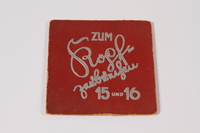
Twelve numbered tiles and box for a game brought with a young German Jewish refugee
Object
Game box with twelve numbered wooden tiles brought with 8 year old Anneliese Centawer when she and her parents James and Recha fled Nazi Germany in July 1938. The tile numbers range from 1 to 15, but there is no number 2, 7, or 11. It is similar in appearance to some versions of a game called fifteen puzzle, but there is no board or platform to contain the loose tiles and the box base seems too high to use for this purpose. After Hitler and the Nazi regime's seizure of power in 1933, the Jewish population was subjected to increasingly harsh persecution. In 1936, Anneliese's family was forced to move from their home in Nuremberg when their block was declared Judenfrei (Free of Jews.) Anneliese was beaten up on the street by a Hitler Youth who accused the freckled, red haired girl of trying to pass for German. In July 1938, with sponsorship from Recha's half-siblings in the US, the family arrived in New York.
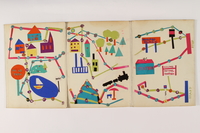
Handmade traffic board game and instructions brought with a young German Jewish refugee
Object
Board game made from brightly colored cut construction paper brought with 8 year old Anneliese Centawer when she and her parents James and Recha fled Nazi Germany in July 1938. It includes several pages of instructions handwritten in English and German. After Hitler and the Nazi regime's seizure of power in 1933, the Jewish population was subjected to increasingly harsh persecution. In 1936, Anneliese's family was forced to move from their home in Nuremberg when their block was declared Judenfrei (Free of Jews.) Anneliese was beaten up on the street by a Hitler Youth who accused the freckled, red haired girl of trying to pass for German. In July 1938, with sponsorship from Recha's half-siblings in the US, the family arrived in New York.
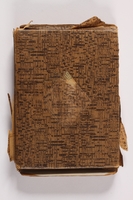
Two decks of Patience cards with 3 boxes brought with a young German Jewish refugee
Object
Boxed set of Patience playing cards, one red, one blue, brought with 8 year old Anneliese Centawer when she and her parents James and Recha fled Nazi Germany in July 1938. The ace of hearts in each deck is stamped with a government control stamp with the Nazi eagle. After the Nazi regime's seizure of power in 1933, the Jewish population was persecuted with increasingly severity. In 1936, Anneliese's family was forced to move from their home in Nuremberg when their block was declared Judenfrei (Free of Jews.) Anneliese was beaten up on the street by a Hitler Youth who accused the freckled, red haired girl of trying to pass for German. In July 1938, with sponsorship from Recha's half-siblings in the US, the family reached New York.
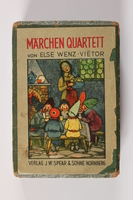
Marchen Quartett deck of fairy tale cards with box brought with a German Jewish refugee
Object
Marchen Quartett, a boxed deck of 40 cards for a fairy tale matching game brought with 8 year old Anneliese Centawer when she and her parents James and Recha fled Nazi Germany in July 1938. After Hitler and the Nazi regime's seizure of power in 1933, the Jewish population was subjected to increasingly harsh persecution. In 1936, Anneliese's family was forced to move from their home in Nuremberg when their block was declared Judenfrei (Free of Jews.) Anneliese was beaten up on the street by a Hitler Youth who accused the freckled, red haired girl of trying to pass for German. In July 1938, with sponsorship from Recha's half-siblings in the US, the family arrived in New York.
Anneliese C. Marx papers
Document
Two (2) composition books used by Anneliese (nee Centawer) Marx in 1937 in pre-war Nazi occupied Germany; documents and photographs surrounding the Centawer family. Includes business contracts from the Centawer family in Nuremberg, early 1900s, documents and photographs related to the military service of James Centawer during World War I, a German passport for Recha Centawer and her daughter, Anneliese, from 1938; a genealogy of the Hutzler family, undated; a letter from an American soldier named Leroy Hutzler, seeking after the well-being of the Hutzler family in Germany, 1919; and a copy of a 1988 article written by Anneliese Marx, and published in New York Newsday, describing her first trip made to Germany since having left it in 1938.
